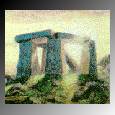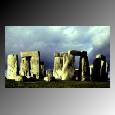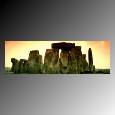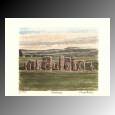




Stonehenge was built in several stages, probably beginning as a henge monument (ritual enclosure) surrounded by a bank and ditch and similar to many others in southern England. It was around 2200 BC that it took on its unique appearance, 82 bluestones being transported from the Preseli Mountains, in south-western Wales. The Altar Stone is believed to have come from a region near Milford Haven, Dyfed.
Stonehenge was undoubtedly built by a people who had widespread trade connections and who established their principal settlements in the area between 1600 and 1300 BC. Its importance is reflected by the fact that the landscape around the monument is dotted by some 400 barrows, circular mounds enclosing burials, dating from between 2000 and 1500 BC; excavation of some of these barrows has revealed rich grave goods as well as chips of bluestone similar to that found in the concentric ranges.
Stonehenge appears to have lost its importance as a ceremonial site at the end of the Bronze Age. It was desecrated sometime between 55 BC and AD 410 by the Romans, who tore down a number of the upright stones. In addition, two uprights and a lintel west of the Altar Stone fell in January 1797, and another upright and its lintel fell in 1900. In 1958 these five stones were raised, giving the monument the approximate appearance that it had during the Roman occupation of Britain. Shallow carvings found (1953) on some of the fallen stones depict bronze axeheads of a type used in Britain between 1600 and 1400 BC and a hilted dagger of a type used in Mycenae, Greece, between 1600 and 1500 BC.